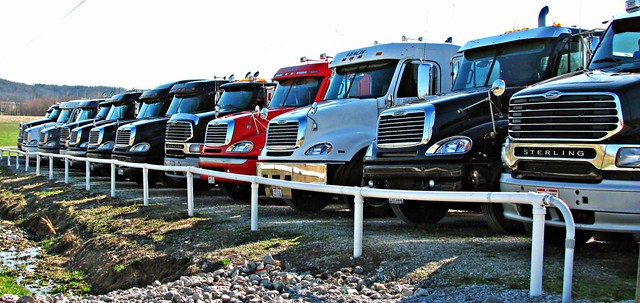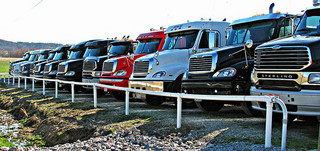Commercial trucking is the backbone of the global marketplace. Truckers haul everything from canned goods and blue jeans to SUVs and heavy materials for new construction. But trucking is an increasingly expensive business, and many companies in this industry are feeling the pinch.

Instead of pursuing more business and heavier loads to improve profitability, Andy Ahern of Ahern & Associates, a transportation management consulting firm, says, “The fastest way to significantly impact your company’s bottom line profitability is not to generate more revenue; it’s to cut costs.”
Like other types of businesses, trucking companies are undergoing significant changes in order to do more with less and stay profitable. Here are three types of expenses that trucking companies can reduce with smart investments in technology.
Fuel and Maintenance
On-board fleet management technology can help trucking businesses and managers monitor the whereabouts of company equipment as well as fuel consumption, maintenance schedules, routes and other aspects of trucking operations. With fuel costs easily representing the biggest chunk of trucking operation expenses, trucking businesses can greatly reduce overall costs by planning the most efficient routes for transport, keeping vehicles in top condition and adopting other efficiency tactics, such as using better tires and aerodynamic attachments on trailers.
With a new trailer for a commercial truck starting at about $50,000, and a cab or truck itself hovering around $100,000 or more, keeping track of the fleet and maintaining it properly to extend the life of every vehicle are critical aspects of efficient business operations.
Noncompliance Fines and Accident Expenses
Electronic onboard recording devices (EOBRs) can also help drivers stay in compliance with Federal hours-of-service (HOS) regulations by automatically tracking driver activity such as drive time, off-duty breaks and periods of sleep and alerting drivers to stop for breaks at the necessary times. This takes the burden off drivers to record these items and minimizes a company’s fines and expenses related to noncompliance. Using this technology along with reliable DOT compliance services you can make sure your fleet is always on the road.
Also, by generating consistent and reliable data on vehicle and driver activity, EOBRs can help fleet managers set realistic expectations for performance. One of the greatest perks of aligning real-world mileage potential with company goals is the potential to dramatically reduce driving behaviors that lead to accidents and other unsafe road situations that carry a significant risk for fines and insurance payments. For example, if the target time for finishing a route is consistently out of line with what a driver can realistically accomplish due to HOS rules and traffic, weather and other road conditions, then a driver may feel a need to drive faster, reduce rest time or skirt a maintenance stop. If caught, these decisions can become very expensive for a driver and his or her employer.
Workers Compensation
The amount of money that trucking companies spend on a typical worker compensation claim is higher than the average claim for workers in other industries. Inside Business reports that “because of the nature of their work, many drivers are out of shape, eat badly, smoke too much, don’t exercise and rarely get enough sleep. As a result, they find themselves susceptible to heart attacks and diabetes, as well as a myriad of strains, sprains and various other muscular-skeletal injuries. This not only makes truckers a danger on the road but also a danger to themselves, to the point that more and more of them are finding themselves mired in the workers’ compensation system, and driving up employer’s costs.”
Current HOS regulations and other initiatives are designed to improve road safety by reducing fatigue and enhancing the overall well-being of drivers. Still, trucking companies need to do more to encourage drivers to improve their health and enhance driver safety in order to reduce injuries and fatigue-related crashes. Here are some ways that companies are trying to reduce worker compensation claims:
- Implementing wellness incentives to improve driver health and well-being
- Initiating pre-employment medical testing to minimize incidence of hiring drivers with conditions that may compromise on-the-job safety and performance
- Consulting specialists who acutely understand worker compensation classification and return-to-work laws and procedures to ensure that insurance premiums and claims are in line with payable incidents

